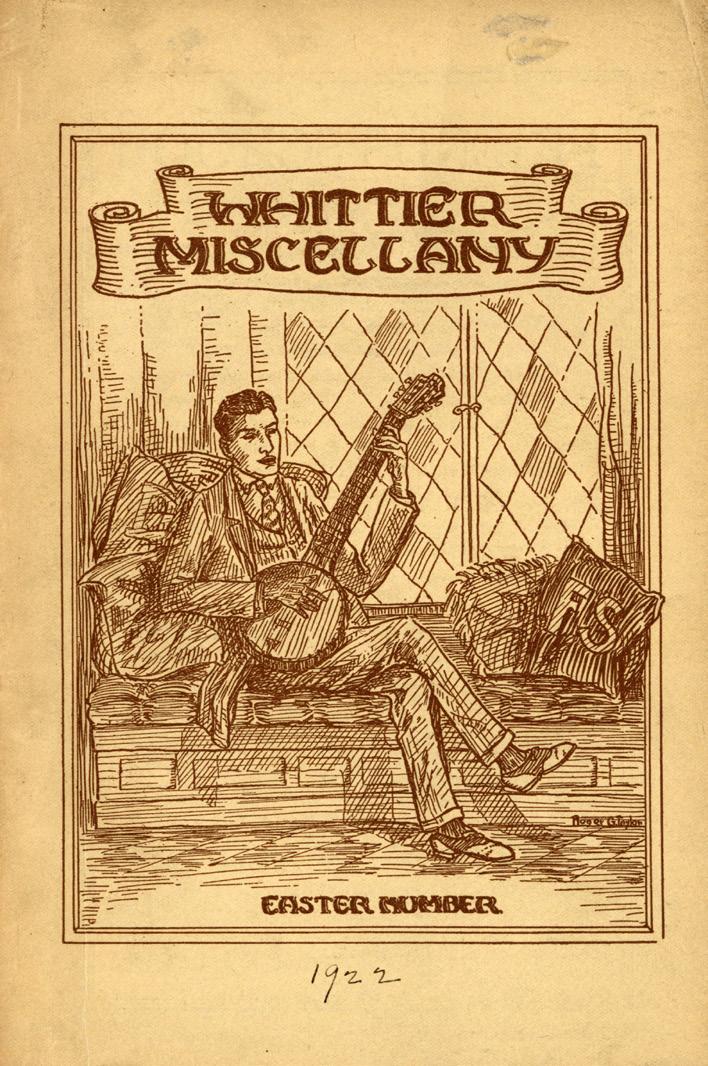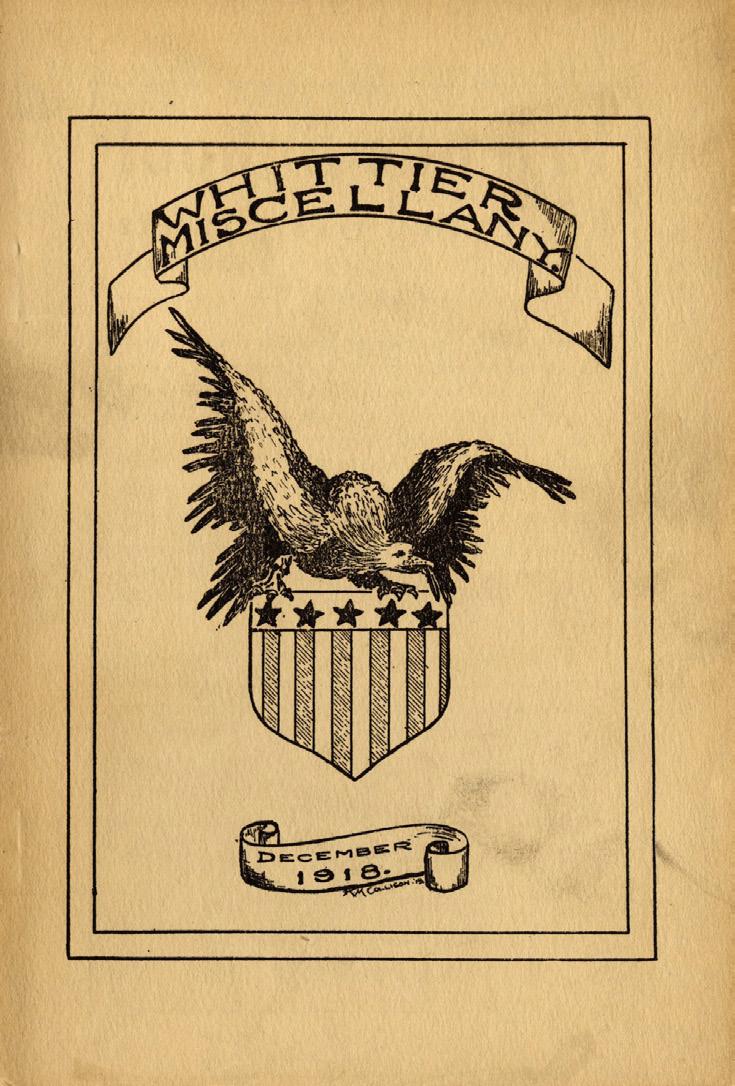
6 minute read
From the Archives
From the WFS Archives
A History of Cartoons and Caricatures at WFS By Terence Maguire WFS Archivist



Cartoons and caricatures have been an important part of American journalism for a long time. Thomas Nast of Harper’s Weekly pilloried political corruption and racism before and after the Civil War. Bill Mauldin followed American troops throughout WWII and brought their experiences home to the American public with humor and pathos. Herblock of the Washington Post attacked McCarthyism, white supremacy, Richard Nixon, and the Vietnam War during his seven decades career. Barry Blitt of The New Yorker has reached great heights of satirical fame skewering former President Trump.
Cartoons and caricatures, demonstrating irreverence and satire, have also been a rich and creative part of the Whittier Miscellany over much of its 125-year history--though not in recent years.
The Whittier Miscellany was first published in April, 1895, 11 years after the Whittier Literary Society was founded, with permission from John Greenleaf Whittier himself. (Whittier was a Quaker and among the most popular American poets of the 19th C.) It was a literary magazine: poetry, short stories, and opinion essays populated the pages of this annual and soon thereafter thrice-yearly publication. Apart from some impressive covers, there was little artwork included in the first few decades of Whittier. This patriotic (if un-Quakerly) cover, just after World War I, was drawn by Emma Holland ’22.
Roger G. Taylor was the first cartoonist/artist whose work was seen over several years. His first effort was this soccer player that introduced the sports section. He also did two fine covers in the 1921-22 school year, including the one depicted top right and then closed the year with caricatures of every senior, including himself. He aspired to be a professional cartoonist. Curiously, he seems not to have graduated; his name is not on the commencement program, and I have been unable to find any mention of him on the web or in alumni files.
Taylor may have created a tradition that lasted for decades, however. The June issue of the Whittier was the Senior issue, celebrating graduation and devoting most of its pages to their formal photos, accomplishments, quirks, and ambitions. Frequently each senior had a small cartoon or caricature of her or him, generally funny, sometimes edgy. Some seniors were probably not amused. Caricatures of the athletic prowess and injuries of Faxie Flinn ’50, the enthusiasm of Frannie Walker ’53, and the etiquette lessons of Nancy Wier ’54 were probably a source of honest fun, but perhaps the depiction of class members as overweight, or apathetic (and there were such caricatures) were not appreciated.

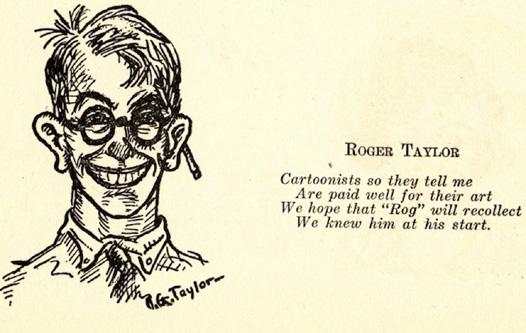
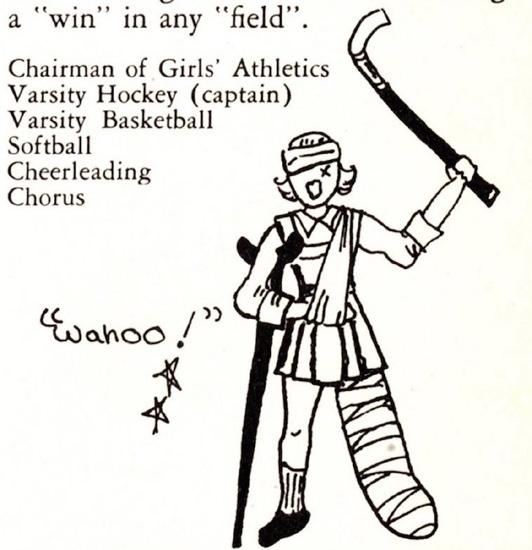



Not surprisingly, during the 1960s edgy cartoons with implicit social commentary began to appear in theWhittier Miscellany. Two late members of the class of 1968, Stephen Burns and John Wyeth, used their skills to lampoon fellow students in these two cartoons.
Burns was also the art editor of the 1968 yearbook and all of the senior section photos were enmeshed in the psychedelic style popular in the late 1960s.
The first Whittier cartoonist whose work satirized both school and national issues was almost certainly the finest cartoonist the School had ever produced: Mike Cooperson ’83. Many of us who knew his work from 1979-1983 assumed that he would become a nationally successful cartoonist working for the Post, The New Yorker, or some other major publication. In fact, at Harvard for undergraduate and Ph.D. studies, he became a scholar of Near Eastern Languages and Civilizations, and is now a professor at UCLA in that same field. Interestingly, he created a cartoon with a commentary about “the college game” when he was a sophomore at WFS.
Cooperson’s cartoons almost always appeared in conjunction with articles of opinion; staff editorials (opinion pieces upon which the entire staff reached consensus); individual op-eds; and even letters to the editor. His style was bold, vigorous, and decidedly liberal/progressive. President Reagan was a favorite target. Some of Cooperson’s other targets, which accompanied other staff editorials, were the gun lobby and proposed federal support for tax breaks for private schools. This was a time when the staff of the Whittier Miscellany–– under excellent editors such as Crystal Nix Hines ’81, Susan Prince ’82, Dave Vernarde ’83, and editorialist John Bonifaz ’84––was strongly progressive, and Cooperson’s cartoons were a powerful reinforcement for those views.
On the other hand, there was a strong belief among the Whittier staff that opposing views should be represented, and it was common for each issue to host Pro/Con editorials on controversial issues. One such issue was women’s involvement in the U.S. military.The MCoop signature often appeared two, even three times in a single issue.
If Cooperson’s editorial cartoons leaned left, his successor as primary Whittier cartoonist, Peter Bethke ’85, was more conservative. He tackled such issues as political bias by WFS faculty. Bethke also created a memorable right-angle cartoon to support the opposed side to the issue of U.S. disarmament vis-a-vis the Soviet Union. He focused on school matters as well, such as the perception that students were subjected to excessive pressure for achievement.
He had a good sense of fun, gently mocking the notion of a “math team” in interscholastic competition, and even poked fun at himself in the cartoon of being too burdened with his cartooning duties to pay attention to his schoolwork.

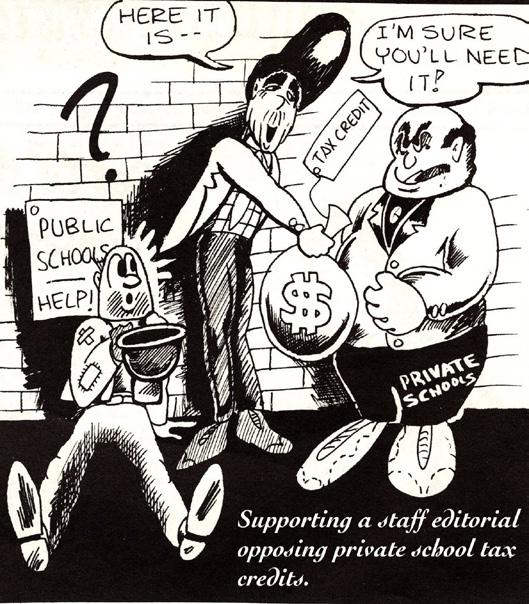



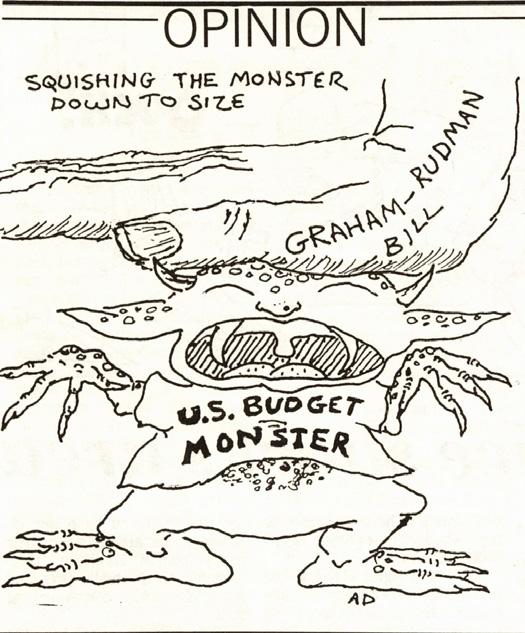
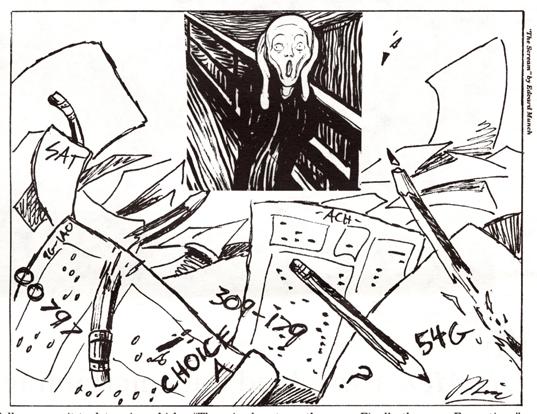

tion of satirical, politically edgy cartooning, as shown by two below that seem to represent both sides of the political divides of the 1980s.
Luise Stromberg ’89 and Joy Linker ’93 drew cartoons for the Whittier, focusing mostly on in-school subject matter. Both went into art professionally.
One cartoonist, in February 1994, captured well the anxiety discussed in an article on new college testing procedures and created a number of effective cartoons during that school year. Efforts to identify this person were made to staff members of that year, but with no success so far. If anyone out there can tag this mystery artist, please help.
In 2007, Diane Murray ’08 captured and lampooned aspects of school life.
The frequency and political nature of Whittier cartoons was much diminished, however. Why? Certainly anyone reading the Whittier knows that the staff has been as much concerned with school, regional, national, and international issues as much as were the staffs of 30 to 40 years ago. Do stock images from the web make it easier to copy and paste? Have young people at Friends grown kinder and gentler, less eager to skewer pomposity and accepted wisdom? Have national political events and figures become too absurd to make fun of, self-parodies that cannot be topped? Maybe all three factors apply.
Below: Whittier cover art by Roger Taylor; Middle School Handbook cover by Mike Cooperson 83; Whittier cover art by Katherine Collison ’(19)19.



